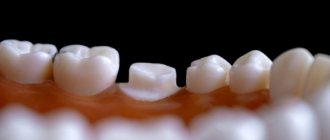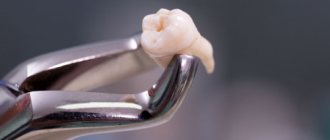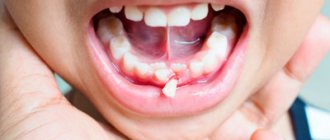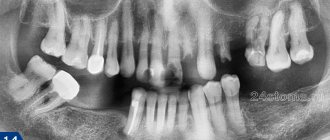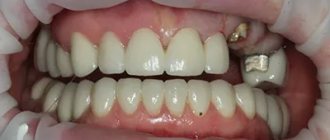Tooth enamel is the hardest tissue in the human body. Up to 90% of calcium reserves are concentrated here. However, cosmetic dentistry regularly deals with defects in this tissue. The fact is that hardness and ductility are different things. With impressive hardness levels, enamel is a fragile material that easily chips and cracks.
The situation gets worse if the enamel is weak. Temperature changes, chronic diseases, blows - and then the tooth breaks off. The situation is unpleasant, and in the long term it is also fraught with caries. Through the crack, bacteria penetrate directly into the tooth, to the pulp, which means that caries will quickly develop into pulpitis. In general, a chipped tooth is a reason to see a doctor, and quickly.
So, what to do if a tooth chips?
- Rinse your mouth with any suitable antiseptic or water to protect the tooth from bacteria and food debris.
- If there is bleeding, apply a tampon with hydrogen peroxide or a hemostatic sponge.
- Apply cold externally to prevent swelling from developing.
- If the pain is very severe, take a pain reliever.
- If a tooth chips on the street, try to rinse your mouth with drinking water (mineral water is also suitable, but not sugary drinks). Other measures can be postponed to your home or the nearest pharmacy.
After that, call your dentist. There is no point in going to emergency rooms - they will simply pull out the affected tooth, especially if a child’s baby tooth has chipped off. You need to eliminate the defect without unnecessary sacrifices.
Fortunately, there are ways to quickly restore a tooth, even if it is severely damaged. There is a whole direction - aesthetic restoration of teeth, it deals with both acquired and congenital defects. Today, restorative dentists work wonders to transform small and uneven teeth into a Hollywood smile. This direction is developed both in pediatric and adult dentistry.
Types of chipped teeth
Restoration methods depend on the damage. Dentists distinguish the following types of chipped teeth:
- Incomplete. A barely noticeable crack appears on the enamel, and the rest of the tooth is not affected. The easiest case, which requires purely aesthetic restoration.
- Enamel chip. If a small piece breaks off from a tooth, most likely only the enamel is damaged. If measures are taken quickly, the deep layers of the tooth will not have time to collapse either.
- Dentin chipping. This layer is located under the enamel, inferior to it in hardness, but reliably protects the nerve and pulp. If dentin is damaged, the tooth usually does not hurt; at most, it reacts to acids and cold.
- Chip exposing the pulp. If a tooth is severely cracked, its darker part is visible, and the person is in pain, this means that the pulp, the most sensitive part of the tooth, is damaged. This is where the nerve and blood vessels are located, so bleeding is common. If the pulp is chipped, you need to make an appointment with a doctor as soon as possible. However, when half a tooth chips off, people usually do not postpone the visit.
When should you go to the dentist?
Immediately after receiving an injury, parents need to pull themselves together and try to calm the baby. The first thing you need to do is make a visual inspection, try to carefully clean the oral cavity from food debris, ask the child to rinse his mouth with boiled water at room temperature or a light antiseptic solution. To relieve the pain a little and reduce swelling, you can apply ice wrapped in several layers of napkins to the cheek on the side of the sore spot. If bleeding occurs, apply a piece of sterile bandage to the wound and immediately go to the doctor.
The first step is to ask your child to rinse his mouth.
What to do if your front tooth chips
Dental defects are always unpleasant, but it’s especially annoying if they are visible. Dentists call visible teeth the “smile zone” and pay special attention to its condition. So, what to do if your front tooth chips? The doctor will suggest the following restoration methods:
- Surface enamel cracks are simply sanded down. You can also saturate the tissue with minerals to speed up recovery. The problem is solved in one visit.
- If the tooth is cracked down to the dentin, grinding is not enough. The crack can be repaired with special materials that resemble a filling. The color is selected to match the enamel. The material is applied layer by layer, illuminated with a special lamp and finally sanded to perfect smoothness.
- If half a tooth is chipped off, it can be restored with a filling or dentures. Are used:
- veneers - decorative overlays on the tooth surface;
- inlays are metal-ceramic structures that replace part of a tooth;
- Crowns are structures that replace the entire visible part of a tooth.
Aesthetic dentistry tries to preserve the surviving tissue as much as possible, since the choice of methods and materials is very wide. But when a tooth is almost completely destroyed, it may be easier to remove it and install a crown or implant.
What if a child has a broken tooth?
First, it is important to understand how serious the situation is? If the front baby tooth is broken at the root, the dentist will most likely recommend removing it. If only a piece of a tooth (deciduous or permanent) has broken off, then removal can be avoided and an attempt can be made to restore it. The pediatric dentist will use filling material or an artificial crown to restore the missing part of the tooth. With severe trauma, the tooth may go deep into the gums (the so-called “impacting”), and initially it may seem that the child has broken the tooth at the very root. Therefore, it is very important to contact your pediatric dentist immediately. If the injury was so severe that the entire tooth fell out of the socket (knocked out), then, if possible, you need to find the tooth and get an appointment with the dentist as soon as possible, taking the knocked out tooth with you. In most cases, permanent teeth can be “implanted” in their original place (replanted). The knocked-out tooth must be placed in warm milk or saline solution, or directly into the child’s mouth, and the sooner your child is in the dentist’s chair, the higher the likelihood of such a tooth being implanted (the clock counts). Baby teeth cannot be replanted.
Baby tooth chipped off
Everyone knows that chipped permanent teeth need to be repaired as soon as possible. However, pediatric dentistry often deals with damage to primary teeth. Children who experience the world by taste are especially often affected: it is enough to pull a stone, a plastic toy into their mouth, or simply fall, and the enamel may not withstand it.
First aid for a child whose tooth has chipped is the same as for an adult:
- Calm down, console.
- Give water to rinse your mouth.
- If necessary, stop the bleeding with peroxide or a sponge.
- Apply cold to reduce swelling.
- If the baby complains of pain, give the usual painkiller.
- Call pediatric dentistry in Krasnoyarsk, explain the situation and make an appointment.
The child will be examined by a doctor and sent for an x-ray to find out whether the soft tissues of the tooth have been damaged. The easiest case is if there is a chip on a tooth that was loose even before the injury. In this case, it is simply removed. But if the tooth holds tightly, treatment is needed. Otherwise, bacteria will penetrate through the crack, and this not only threatens the destruction of the baby tooth, but can also lead to problems with permanent ones.
At Mira Dentistry, we know how to find an approach to children whose baby teeth have broken off, even very young ones. After all, choosing a treatment is not difficult; it is more difficult to get a frightened child to trust the doctor. Correction methods are generally the same as for adults: polishing, remineralization, restoration with a filling.
A child's tooth chipped. What to do?
Most often, a child, especially a small one, gets a chip as a result of an impact accompanied by pain. What to do in such a situation?
- First of all, the child needs to be reassured;
- Next, a visual inspection and rinsing the mouth with water is required;
- If the lip is damaged, it should be treated with antiseptics;
- If there is a broken fragment, it must be placed in saline or milk;
- Visit the dentist as quickly as possible. This must be done within 24 hours, or preferably a few hours.
The faster a specialist sees a tooth, the greater the chance of its survival and absence of infections.
Today, there is a broad classification for dental injuries based on etiology and anatomy. The proposed classification is based on the standards of the World Health Association, and is included in the ICD Appendix in the “Dentistry” category.
Prevention of chipped teeth
The golden rule of medicine: prevention is easier than cure. Prevention of chipped teeth requires:
- Avoid mechanical damage. Those at risk include fans of seeds and hard nuts, as well as those who like to chew pens and pencils.
- Avoid temperature changes in food. Ice cream with coffee is delicious, but if you regularly treat yourself to a combination of hot and cold, you can end up with microcracks in your enamel and an unscheduled visit to the dentist.
- Teenagers and adults: use protective mouthguards when playing traumatic sports. We are talking about boxing and other types of wrestling, hockey, rugby, handball - all where there is a high risk of getting hit in the face and, consequently, a chipped tooth.
- Eat properly. Lack of calcium is the most obvious cause of weakened enamel.
- Monitor the health. Many chronic diseases affect the condition of teeth. With diabetes, gastrointestinal disorders, and endocrine problems, the risk of getting a chipped tooth increases.
And, of course, it is worth monitoring your oral hygiene and regularly visiting adult or pediatric dentistry in order to notice and treat problems with enamel in time.
Causes of enamel cracks in children
The main condition for the appearance of an enamel crack is an impact that exceeds its safety factor. This can happen either when it becomes thinner or due to very severe trauma (both instantaneous and regular). The list of the most common causes of pathology includes:
- blows falling on the tooth area;
- the habit of chewing candy, nuts and other hard foods, as well as opening bottles with teeth, etc.;
- use of pastes with a large number of abrasive components;
- deficiency of vitamins and minerals, leading to thinning of the enamel;
- bruxism: grinding teeth while sleeping;
- dental errors when treating caries and performing other manipulations;
- abuse of products that corrode enamel (certain types of soda, fruit, etc.);
- wearing braces;
- poor oral care;
- orthodontic problems leading to uneven load on the dentition during chewing.
How much does it cost to fix a chipped tooth?
It happens that people do not seek help because they think that dental restoration is very expensive. In fact, it is easier and cheaper to immediately “fix” a chipped tooth than to wait for bacteria to penetrate through the crack and have to treat pulpitis. Moreover, all our services are available in installments.
In Mira clinics, prices for correction of a chipped tooth start at 2,000 rubles. — this is how much it costs to restore the edges of the front teeth. The final cost of treatment depends on the volume. You can call the clinic and we will tell you how much it costs to fix a chipped tooth in your case. But it’s better, of course, to make an appointment for an inspection - only after assessing the damage can you give an exact price. “Mira” is your dentistry, Krasnoyarsk is not in vain turning to us!
Tooth fracture without pulp exposure
In dentistry, a fracture is understood as an injury in which the enamel prisms diverge from each other, and part of the dental tissue is lost. In the event of a fracture, the prisms are not only separated, but also parts of them are lost. The fracture can also pass through dentin, but in this case the dental pulp remains intact.
X-ray
When conducting radiographic studies, if a child’s tooth has chipped, it is not difficult to determine serious damage, while it is almost impossible to recognize a crack in the picture.
Treatment and postoperative monitoring
For small chips, grinding down the enamel is possible, but for more extensive damage, a composite tooth restoration may be required.
In cases where the patient was able to save the chipped tooth fragment, it is possible to fix it in place using adhesive bonding techniques. The technology for performing the work is fully consistent with the methods used by dentists when providing services for complete dental restoration with composite materials.
Recent laboratory studies have proven that with the use of modern adhesive materials, it is possible to restore the reliability of the connection of the broken area of the tooth, corresponding to the intact tooth.
To increase the aesthetic appeal of the tooth being restored, it is recommended to first create a bevel of small width from composites around the entire perimeter of the broken area, reaching 1-2 mm depending on the specific situation.
Forecasting
After recovery, the patient is required to visit the dentist 2 and 12 months after the procedure. In cases where tooth sensitivity remains within normal limits, there is no need for further observations. The risks of complications due to the pulp are minimal.
What experts advise for prevention
As in the case of any other pathological conditions, it is always better to prevent unpleasant consequences than to later engage in long and costly, and sometimes quite painful, treatment. To reduce the risk of damage and destruction of children's primary incisors and molars, it is necessary from an early age to teach the child to take a responsible approach to oral care, brush his teeth every morning and evening, and follow all basic hygiene rules.
It is worth keeping a close eye on your baby while he is playing. Try to exclude all traumatic factors. Later, if the child begins to engage in traumatic sports, he should be given an individual protective mouthguard - this service is provided by many modern dentists.
It is worth keeping a close eye on your baby while he is playing.
But finally, in no case should you ignore any pathological changes in the oral cavity, even if there are only temporary baby incisors and molars. If there is a clear malocclusion, orthodontic treatment should be started promptly. If caries and inflammatory processes develop, immediately show the child to a specialist. Parents need to remember that any advanced dental diseases can easily damage the buds of permanent teeth, which will inevitably affect their condition and health in the future.
1Eradze E.P., Osipov G.A. Modern methods of treating acute dental trauma in children, 2001.


